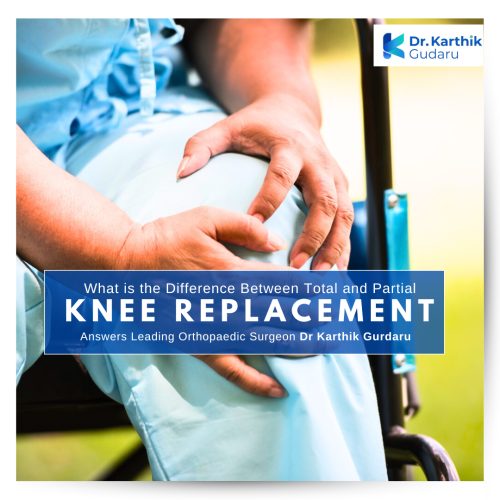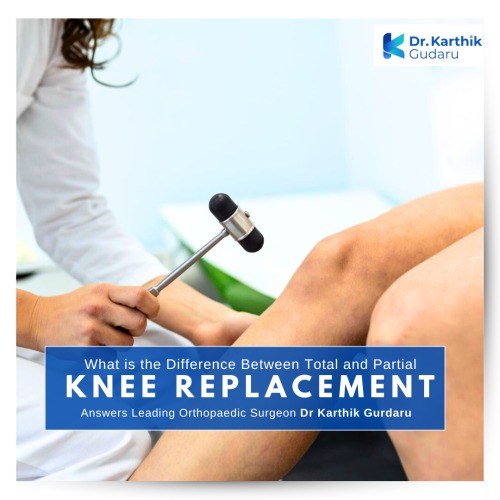Knee problems, especially those caused by arthritis or injury, can significantly affect mobility and overall quality of life. When conservative treatments such as medications, physiotherapy, or injections fail to provide relief, knee replacement surgery becomes a viable solution. Knee replacement aims to restore joint function, reduce chronic pain, and help patients regain mobility.
Among the surgical options, total knee replacement (TKR) and partial knee replacement (PKR) are the most common procedures. Understanding the differences between these two approaches is essential for patients and doctors to make an informed decision, shares Dr Karthik Gudaru, leading orthopaedic surgeon and specialised knee replacement surgeon in Hyderabad and Telangana.
What is Knee Replacement?
Knee replacement, also known as knee arthroplasty, is a surgical procedure in which a damaged knee joint is replaced with artificial components called prostheses. The knee joint consists of three main compartments: the medial compartment on the inner side, the lateral compartment on the outer side, and the patellofemoral compartment beneath the kneecap.
Conditions such as osteoarthritis, rheumatoid arthritis, or severe trauma can cause damage to these compartments, resulting in pain, swelling, stiffness, and difficulty walking. The primary goal of knee replacement surgery is to relieve chronic pain, restore normal function, and improve the patient’s quality of life.

Total Knee Replacement (TKR)
Knee replacement involves replacing all three compartments of the knee joint — the medial, lateral, and patellofemoral compartments — with artificial implants. This procedure is generally recommended for patients with severe arthritis affecting the entire knee, rheumatoid arthritis, or significant deformities.
During the surgery, the damaged bone and cartilage are removed, and prosthetic components made of metal and plastic are implanted to recreate a smooth and functional joint surface. Total knee replacement provides substantial pain relief and has a high long-term success rate.
Partial Knee Replacement (PKR)
Partial knee replacement, also known as unicompartmental knee replacement, involves replacing only the damaged compartment of the knee while preserving the healthy bone, cartilage, and ligaments in other parts of the joint. This procedure is usually recommended for patients whose arthritis or damage is confined to one compartment of the knee.
By focusing only on the affected area, partial knee replacement is less invasive, allows for faster recovery, and results in a knee that feels more natural after surgery. Despite these advantages, it is not suitable for patients with widespread arthritis, and there is a possibility that the patient may need a total knee replacement in the future if arthritis progresses to other compartments.
Key Differences Between Total and Partial Knee Replacement
The main difference between total and partial knee replacement lies in the extent of the joint replacement. Total knee replacement addresses all three compartments of the knee, making it suitable for severe and widespread arthritis, while partial knee replacement targets only the affected compartment, making it ideal for localised damage.
The decision between the two procedures depends on several factors, including the severity of arthritis, patient age, activity level, and overall health. Both total and partial knee replacement surgeries are effective options for managing knee pain and improving mobility, but the choice between them depends on the extent of knee damage and the patient’s individual needs. Total knee replacement is recommended for severe, widespread arthritis, while partial knee replacement is ideal for localised damage and offers a quicker recovery with a more natural feeling in the knee. Consulting an experienced orthopaedic surgeon is crucial for selecting the procedure that will provide the best long-term outcome.

Dr. Karthik Gudaru has successfully performed a wide range of advanced orthopedic surgeries, including Total Knee Replacements, Hip and Shoulder Replacements, Elbow Joint Surgeries, and complex pediatric orthopedic procedures. He has a special expertise in robotic and computer-assisted surgeries, sports injury management, and regenerative orthopedics. His key areas of specialization include Robotic Knee Replacement, Shoulder Arthroscopy, Revision Hip Surgery, Spine Surgery, PRP & Stem Cell Therapy, and pediatric conditions like cerebral palsy, congenital deformities, and polio sequelae.
